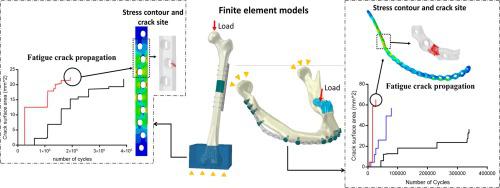International Journal of Fatigue ( IF 6 ) Pub Date : 2021-02-01 , DOI: 10.1016/j.ijfatigue.2021.106160 Boyang Wan , Ali Entezari , Zhongpu Zhang , Tom Wilson , Nobuhiro Yoda , Keke Zheng , Chi Wu , Guangyong Sun , Keiichi Sasaki , Michael Swain , Qing Li

|
While prosthetic devices have been extensively used to treat a wide range of human diseases and injuries, failure of these devices due to fatigue under cyclic loading has been recognized as a primary concern on therapeutic longevity. Experimental testing has long been a dominant approach to characterizing the fatigue behavior of prosthetic devices. However, experimental methods could be of multiple shortcomings such as their restrictive nature in-vivo in medical studies and limitations of extrapolating the testing results. This study develops a numerical approach for modeling fatigue failure in some commonly-used osteofixation devices that are implanted to support various major bone defects/trauma and fractures. The eXtended Finite Element Method (XFEM) is employed herein to model fatigue crack formation and propagation as per level set functions to suppress the need for re-meshing. For validation purpose, a benchmark problem involving a modified compact tension structure is first carried out, in which the modeling results are compared with the relevant experimental data to demonstrate the effectiveness of the proposed XFEM approach. Further, two representative orthopedic examples are studied for characterizing the fatigue behavior of a femoral osteofixation plate and a mandibular reconstruction mini-plate, respectively. The results reveal that healing/remodeling of grafted bone as well as tissue ingrowth to the scaffold have significant bearing on fatigue life of fixation plates. This study showcases a valuable approach for predicting fatigue failure of prosthetic devices in-silico, thereby providing an effective tool for design optimization of patient-specific prosthetic devices to ensure their longevity.
中文翻译:

通过XFEM分析预测假肢设备的疲劳失效
尽管假体装置已被广泛用于治疗各种人类疾病和伤害,但由于循环负荷下的疲劳而导致的这些装置的故障已被认为是治疗寿命的主要考虑因素。长期以来,实验测试一直是表征假体设备疲劳行为的主要方法。但是,实验方法可能有多个缺点,例如它们在体内的限制性性质在医学研究中以及推断测试结果的局限性。这项研究开发了一种数值方法,用于模拟一些常用的骨固定装置中的疲劳失效,这些装置被植入以支持各种主要的骨缺损/创伤和骨折。本文采用扩展有限元方法(XFEM)来按照级别集函数对疲劳裂纹的形成和扩展进行建模,从而抑制了重新网格化的需求。为了验证目的,首先进行了涉及修改后的紧凑张力结构的基准问题,其中将建模结果与相关的实验数据进行了比较,以证明所提出的XFEM方法的有效性。进一步,研究了两个代表性的骨科实例,分别表征了股骨固定板和下颌重建微型板的疲劳行为。结果表明,移植骨的愈合/重塑以及支架向内生长对固定板的疲劳寿命有重要影响。这项研究展示了一种预测假肢疲劳失效的有价值的方法在计算机芯片,从而提供一个有效的工具为特定患者的假体装置的优化设计,以保证他们的长寿。


























 京公网安备 11010802027423号
京公网安备 11010802027423号